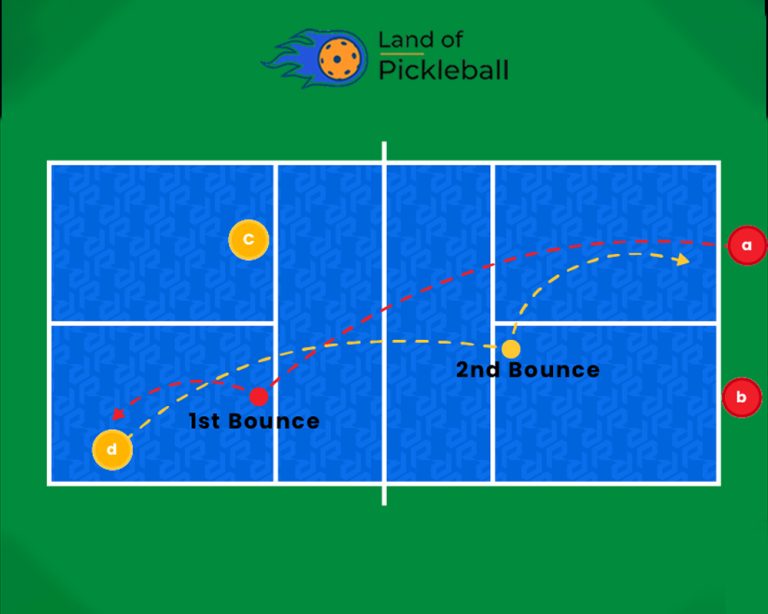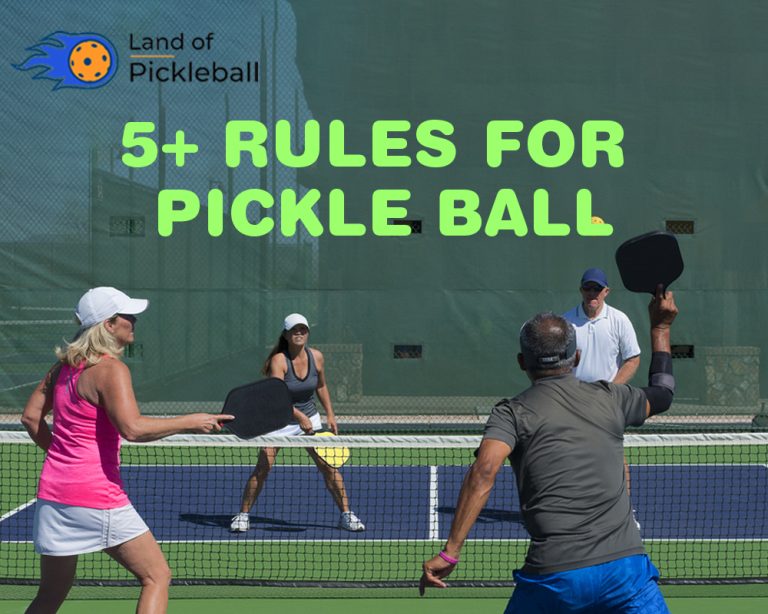Basics of Pickleball | 8 Beginners Points
Grasp the basic points of Pickleball is essential with rising popularity. Indoors and Outdoors are playable whether in singles or doubles to make 11 points.
It would be difficult to find the scattered basic rules of Pickleball or might be tough to understand all basic but advanced rules.
Staying away from such disputes of scattered data, here’s a list of Pickleball basics that are more effective for beginners. Once you take a step to learn about this gameplay, you’ll find solid strategies to understand this trendy sport.
Eight Basics of Pickleball Play
These masterpieces (Pickleball rules) are essential to learning if you have never played this game before. These are the barebones, players usually need to follow while participating in the game. Moreover, here you have the entire rulebook to jumpstart the Pickleball match.
Basics of Pickleball; Rules for Beginners
Rule 1. Pickleball Play is available for Singles and Doubles
The Pickleball sport allows over four players to play on the court. These four players are essential while playing the doubles; two teams are here with two players in each.
Likewise, two players will be on the court for singles gameplay. Well, it is played in a new one-on-one manner. The official authority of USA Pickleball rules stated that the ‘Majority of Pickleball matches played are doubles Pickleball than Singles matches.’
Pickleball Doubles is a remarkable and beginner-friendly game. It’s because it lessens the amount of movement on the court. It makes the game easier for new gamers who come to court for the first time. Well, two players are on each side, so both teams need to occupy less ground area.
Moreover, having a companion player adds more amusement to play and is effective for the basics of Pickleball understanding. It makes the contest more familiar, and it’s all fun and game. A doubles tournament is a high-recommendable approach.

Rule 2. The server is allowed to make a Score Point
Serve initiates the match in Pickleball. There are several serves, including drop, power, traditional, etc.
According to the official rules management of Pickleball, the server can make a point. However, there are three major categories of players, server, serving team, and receiving unit. The doubles pickleball exposes one of two players of the server team. That specific player is at the right corner of the Picklecourt and starts scoring from even numbers as 0 – 0 at the initial stage.
The server team diagonally hit the ball opposite to the opponent team side. At that time, the server team makes a score, moves to the left, and then returns to their right corner for the next score.
Meanwhile, the Pickleball Basics remarkably include that if the server team violates the rules or makes a fault, then serve handovers to the opponent team.
In Singles Pickleball, the ball goes to the second player when a player breaks the game’s official rules. The second person can make his score points until he makes the fault.
How is math “Started,” and Players make scores?
It might be a surprising rule for beginners but keep learning about the rules of Pickleball court. The scores are initiated from the word “Start” as -0 – 0 -.
During the Double Pickleballs match, three categories participate to explain the game rules. Moreover, Serve denotes these three numbers. The first one is the serving team, the second is the receiving team, and the third number indicates the server number, which is the serving team, and its number is first or second. Suppose the serving team is playing at first, and the server number is represented by 1 while the second server player is 2. The score is achieved described as 1 when the game is started.
There also come some technical masterpieces like the First-Server Exception rule and sideout. The first serving team initiates their match journey from Start with 1 score, and when they finish their Serve, it’s known as the sideout rule.
Rule 3. Coin Tossing for Server Selection
Do you know who will come to play and hit the score at first in Pickleball? It’s a general query for beginners. It’s a new ball game where you can add fun to play. So the basics of Pickleball rely on team selection methods. Who comes to serve at first is decided by randomly flipping the coin. Now check the coin position as you have determined your head and other as tail positions. The winning team will serve first and start the game.
Rule 4. Pickleball once bounces on each side
Pickleball sport introduces a new double-bouncing rule: “when the first Serve is achieved, your ball must take single bounce instead of double bounce before the receiver team hits the ball. After that server must return it with a single bounce before the other team hits again.”
If the ball makes double hits, it’s counted as the fault of that team. It must bounce at once on one side. Thus, if double bounces happen from your team, you should initiate the volleying of the ball, or you may play off.
The more important thing is this Double-Bounce Rule is applicable only at the Start of your tournament. I can’t be applied at other later steps in the rest of the game.
You may call this rule a double-bounce or two-bounce rule. It’s figured out from the official Pickleball Rules community, and they changed its name according to the better reasons of it.
The latest term of Double-Bounce characterizes as the ball bouncing twice in each direction of your court. That mistake loses your scoring chance. Although, you need to stay away from the double-bounce fault.
However, your concept about this Double-Bounce is being cleared, and the USA changed its name. Our authorized community is always ready to make straightforward rules for Pickleball beginners. If you hear its old word as a two-bounce rule, you must remember that it’s about double-bouncing. Eventually, this guide is compulsory to understand the basics of Pickleball.
Rule 5. Your Ball must be in bounds
The pickleball court lines are not only serving guidelines but also bound lines for both teams. Once the ball hits out of the bound, it’s considered as a fault of that team. It’s a definite thought, and now your opponent team will lead the serve as you have lost your score.
The next essence is the Non-volley (Kitchen) region, the specifically marked zone which stretches the 7-feet distance from both sides of the Pickleball court net. It also runs along the width of your court.
When your ball runs in the kitchen zone while Performing a service motion, leading to the fault. It includes the kitchen line that distinguishes this zone from the rest of the service court. Meanwhile, you can hit your ball any other time during the game. Even you can stay in these regions whenever you want. Just you are not allowed to volley in it when making the serve.

Rule 6. Legal Volley Serve is underhanded Serve
Tennis to Pickleball migration is familiar for various players. On the other hand, there are some similarities between these two games. One key adjustment is to note to the tennis player how they can make the service motion (serve) in Pickleball.
While in the basics of Pickleball Court, there are two major legal services; the most popular one is legit if it’s done underhandedly. It’s the traditional service and is referred to as the volley serving.
Once the paddle comes in contact with your ball, the essences of volley legal serve are:
Players have to set the paddles in addition to the net and court. The Pickleball paddle is relatively more extensive than that of the table tennis.
According to official laws, each player has 1 chance to serve. Therefore, the serve is performed when the ball is moving diagonally across your court to the opposite side from you and land in the service area of the court. If the ball is stopped due to obstacles such as the net, doesn’t go far enough, lands in your opposite team’s volley, or falls short of the net, these are your faults.
Meanwhile, you are the 1st server in the doubles match and have made a fault. Officially serve will go to your conflicted team. At the same time, you are a 2nd server (singles match). Now on fault, serve is granted to your opponent team. Here it is stated as a sideout.
Rule 7. Serve Behind the Pickleball Court Baseline
The baseline is one specific marking point that runs around the whole court width, and you can see the parallel marks to your net. Remember this baseline is the anchor point for serving.
To make a legal serve, players need to stay behind the baseline. While at the moment of making the serve, they can put their one foot planted to the surface.
Let’s suppose two lines make the baseline’s horizontal boundary; the sideline is for the outside width, and the centerline is the middle row of the court. Servers should not move beyond or touch these lines.
Once you’re serving, for excellent betting, you must move in the middle regions of both the sideline and centerline, on the spot, and also stay behind the baseline. Here you are one step behind, so it’ll ensure you never cross the baseline and never move beyond the game confines.
Especially pay attention to your feet’ position.
Rule 8. The game ends at 11 Scores
There is no allotted time in the basics of Pickleball game. Thus it’s not a time-based tournament. So, the team with higher scores is capable of winning the match.
Although, the first team with 11 scores and at least two extra points from the other opponent team is declared as a winning team.
The main rule is simple, but sometimes settings are quite different. Often, the Pickleball tournament is ended at 2 best games out of 3 and at 11 scores in each game. On the other hand, you may set your scorecard as playing 15 games or even 21 rounds, depending on you.
On account of the rulebook about ‘basics of Pickleball,’ in non-tournament matches (fun games), a scorecard of more than 11 points is uncommon.
Final Thoughts
Here are the basics of Pickleball; now it’s your turn to build your own Pickleball Court. Although these eight steps are the bare minimum, you must know to play this game. Luckily, you’ve dug deeper into the details and found the more complicated rules. Let’s keep expanding your knowledge about the fastest-growing sport in the US.
The basics of Pickleball are more familiar for beginners now. It’s the funniest game and more relaxing than other games of the same category. You need to keep the practice of this game, and you’ll learn the core rules of this game.





